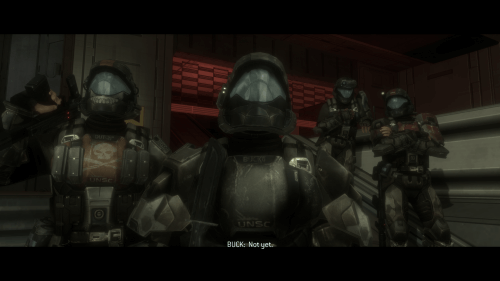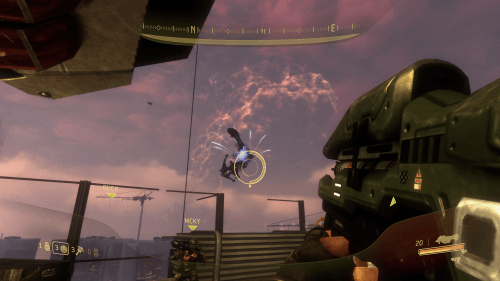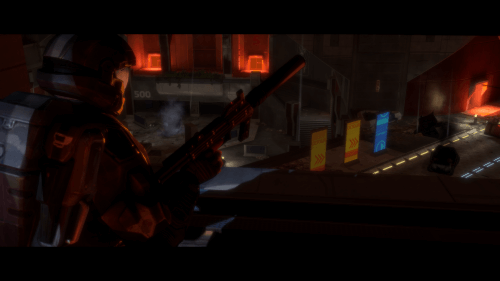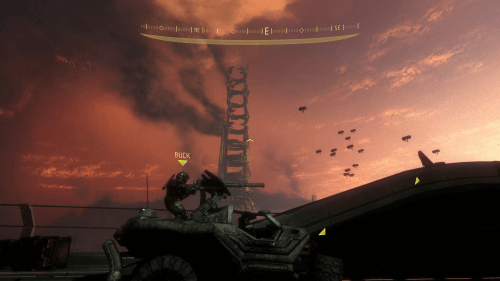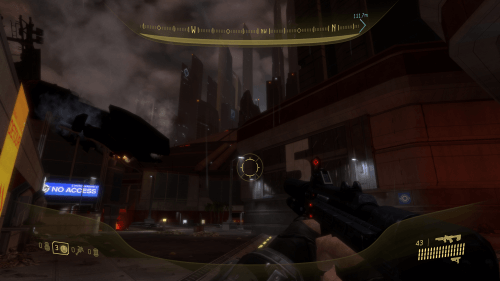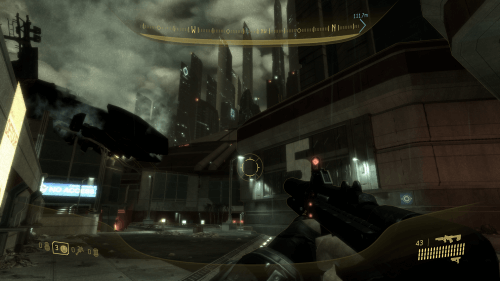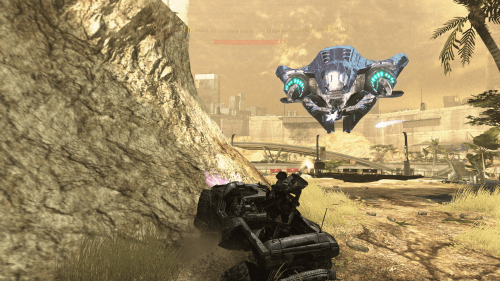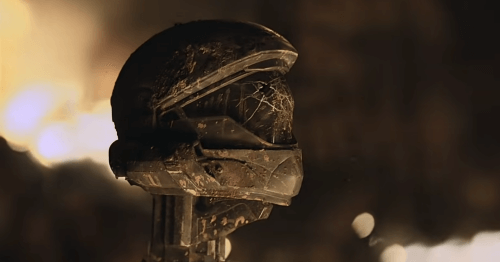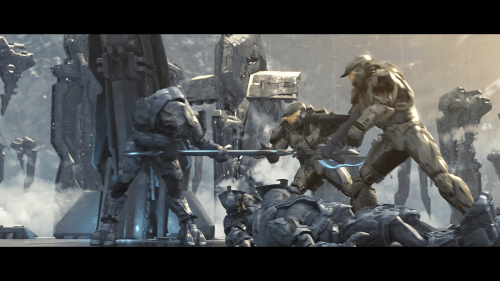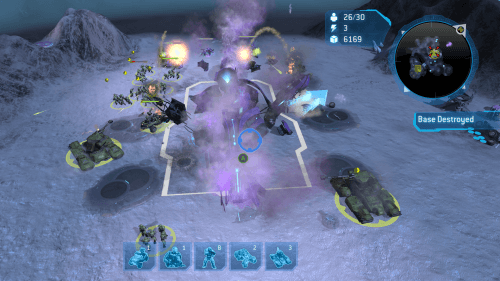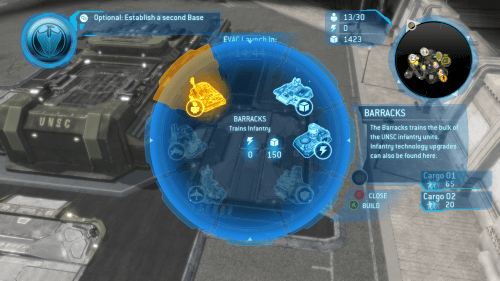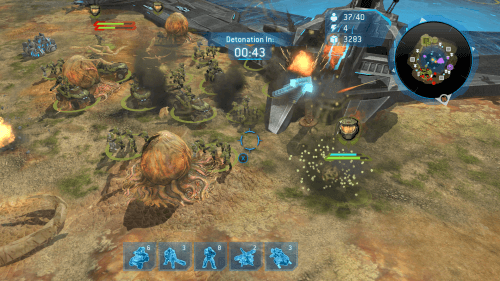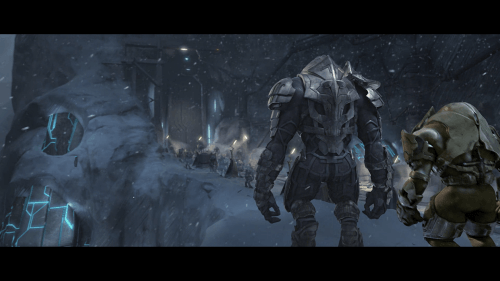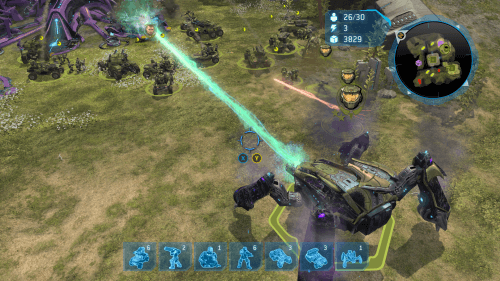Even more than with Halo 3: ODST, I was hyped-up for the release of Halo: Reach. By this time we knew that Reach was going to be Bungie’s last Halo game and between previews and Bungie’s own PR, it sounded like they had every intention of sending the series off with a bang. While I was a bit disappointed that early rumors of Reach being a more squad tactics oriented game were never realized, the game we ended up with was still my favorite entry in the series up to that point (at least, when I’m not nostalgically giving that credit to Halo: CE.) As with ODST, I only really played through Reach’s campaign once, just after its release, and I was looking forward to playing through it again. I wasn’t disappointed.
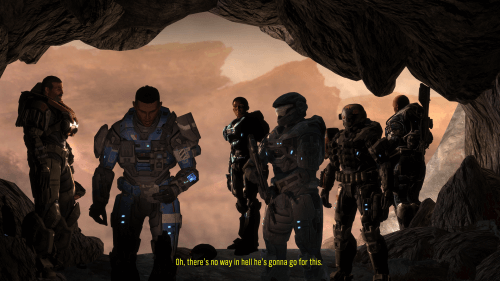
“Everyone to the cave for a team meeting!”
Despite my praise, Halo: Reach ended up being controversial to much of the hardcore fanbase for various reasons, from its lore departures from most people’s introduction to Halo fiction, The Fall of Reach by Eric Nylund, to a plethora of mechanical adjustments that, while seemingly small on the surface, drastically changed the landscape of multiplayer – from overpowered and gimmicky armor abilities such as armor lock, jetpacks, and sprint, to reticle bloom and the overreliance on Forge-built maps, just to mention the highlights. Even today Reach is blamed for killing the Halo competitive scene, beginning a downward spiral as Halo headed into the 343 Industries years. Thankfully, being relatively casual multiplayer players, me and my friends didn’t have too many complaints on this front. The game felt a little different, sure, but each iteration does, and hey, fucking jetpacks!
Halo: Reach was added as part of the Master Chief Collection almost 10 years after its original release, and of course, that’s how I played it on my Xbox Series X for this playthrough. Like MCC’s Halo 3 and Halo 3: ODST, Reach didn’t receive a remaster as much as a straight port with requisite improvements to its resolution, textures, and framerate. That’s okay, as Reach was certainly a major technical leap from Halo 3 if not one of the Xbox 360’s best looking games, period. It’s just an amazingly beautiful game all around, and it still holds up rather well today thanks to the abundance of care and polish Bungie put into it. Save for some occasionally stiff looking character animations and some odd looking facial and hair texture and lightning issues, it even manages to look fairly modern.
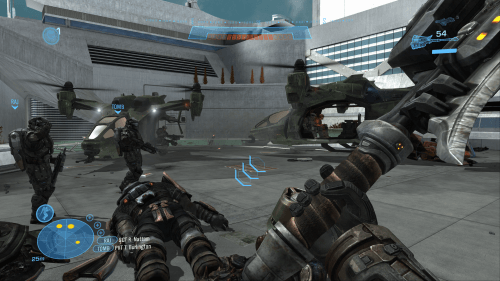
“MY gravity hammer!”
Iterative technical improvements aren’t anything new for the series, of course, but one major departure from the rest of the Halo games is the story. While still conjuring the typical themes of heroism against overwhelming odds, sacrifice, like, real loss of life sacrifice, is a huge theme in Reach. As such, the game has a much darker, more mature story than any other Halo game. Characters die, the heroes of the story aren’t conventionally victorious, and as such, Reach is utterly lost to the Covenant. Hopefully none of that was too spoilery. In fact, since this is a side story taking place out of chronological order from the main series anyway, I’ll recap the plot now. While I’m fairly vague in these plot summaries they absolutely do still contain spoilers, so skip the next two paragraphs if you want to avoid them.
The Story: NOBLE Team, a SPARTAN special operations fireteam assigned to the colony world Reach, is dispatched to investigate a blackout at a major communication hub. NOBLE quickly discovers a Covenant advanced team in the area, triggering a planet-wide emergency declaration. A short time later NOBLE participates in a reconnaissance mission that leads to the discovery of a large invasion force gathering on the planet’s surface. In response, the UNSC launches a massive preemptive strike, taking down a number of Covenant teleportation spires and anti-air batteries before progress comes to a devastating halt when the Covenant supercarrier Long Night of Solace appears. Lacking sufficient weapons to take down the supercarrier, NOBLE is dispatched on a mission to commandeer the slipspace drive from a UNSC frigate, infiltrate a Covenant corvette, and then detonate the drive close enough to the supercarrier to cripple it. Manually detonating the drive, NOBLE-5 successfully destroys the ship, though sacrificing himself in the effort. Victory is extremely short lived as an enormous Covenant fleet jumps into orbit only a short time later. NOBLE team is assigned to assist evacuation efforts in the city of New Alexandria during which NOBLE-2 is killed in action and the city is completely annihilated. With a full withdrawal now underway, NOBLE is dispatched to ONI Sword Base on a demolition mission. Fighting their way into the base, the team is led into a secret research facility built around a large underground Forerunner ruin where they meet Dr. Halsey, the head scientist behind the Spartan program. Halsey tasks the team with carrying new information that she believes will be vital to the war effort safely off world. NOBLE-3 accompanies Halsey while the remainder of the team head to the shipyard where the UNSC cruiser Pillar of Autumn is waiting to depart. NOBLE-1 sacrifices himself clearing the way for NOBLE-4 and NOBLE-6, who manage to clear the shipyard, repelling multiple waves of Covenant attackers before NOBLE-4 is killed. NOBLE-6 delivers the package to Captain Keyes but elects to stay behind to man an anti-air battery, helping the Pillar of Autumn to escape. NOBLE-6 is eventually overcome while the Pillar of Autumn jumps to safety where it is revealed that Dr. Halsey’s information is contained in the AI Cortana and that the Pillar of Autumn has just jumped to Halo Installation 04.
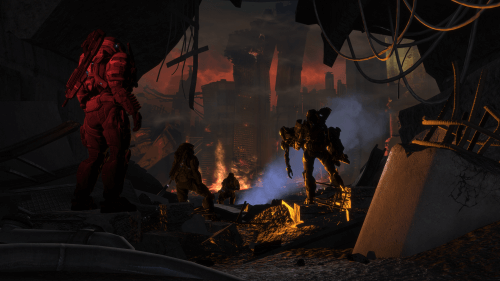
“There are so many beautifully framed cutscenes but this one was especially poignant.”
The focus on Master Chief as the hero of the series has mythologized the idea that Spartans are practically demi-gods so actually seeing them dying left and right in a Bungie developed Halo game was, hopefully, a bit of a wake up call, even if most of them being SPARTAN-IIIs provides something of an out for diehard fanboys. The events of Reach also send home how overwhelmed humanity was by the Covenant. They had the technical and numerical superiority and a fanatical cause driving them, and humanity was being systematically wiped out. Finally, I love how the end of the game brings the series full circle, with the last moments of the campaign being precisely where Halo: Combat Evolved starts. Knowing that NOBLE’s sacrifice directly led to and enabled the events of the main trilogy made it all the more effective, putting a positive spin on an otherwise somber story. It also managed to conjure up some unexpected but powerful nostalgic emotion in me, even the second time through.
Appropriately, Bungie seemed to go back to the original game for a lot of inspiration. Based on original designs, the Covenant species feel more alien and more menacing. Even those adorable little grunts are less overtly silly and are all-around tougher than they’ve ever been before. In fact, playing through Reach on “Heroic” felt a lot more like the difficulty of Halo: CE or even Halo 2 than Halo 3 or ODST. While I don’t remember being utterly stuck at any point, I definitely feel like I had a lot more back to back deaths this time around. Part of that was due to Reach’s reliance on Firefight arena style map sections where you’d need to defeat wave after wave of enemies before moving on. I know ODST is the game with the reputation for overusing this mechanic, but I honestly felt it more with Reach.
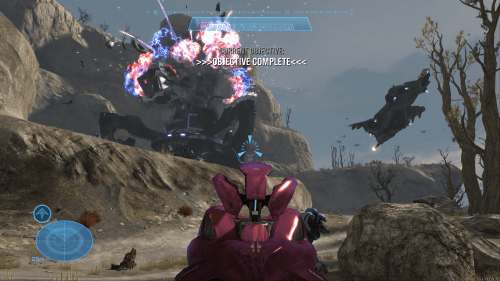
“Kat and I taking our new Revenant out for a spin.”
There were plenty of departures too. The aforementioned “armor abilities” were probably the biggest single change to the Halo formula. Replacing Halo 3’s equipment system, armor abilities allow the player to activate a single on-demand power, most governed by a recharging energy pool. These abilities are all over the place, from classics like active camouflage and the bubble shield, to seemingly simple ones like the ability to sprint or dodge roll. The biggest two additions are the jetpack, which is a little controversial but I’m personally a fan of hopping around all over the place like an idiot, and armor lock. Armor lock essentially makes the player totally invulnerable while on, while an EMP pulse charges and is unleashed once the lock is over. The player’s health and shields will also recharge as normal during the lock. In the campaign this could be useful for preventing big damage or doing an emergency recharge (although the enemy AI tends to simply stop and wait around for the armor lock to end, with feels a little stupid) but in multiplayer the ability to be invulnerable on-demand combined with the situationally usefulness of the EMP pulse altered the flow of fights in a way that many people thought was devastatingly overpowered.
Halo Reach only includes one new enemy, the barely noteworthy Skirmishers which come in several varieties, although all of the classic Covenant enemies have been re-tuned and come in several varieties themselves. Weapons wise, we have a lovely new battle rifle stand-in called the designated marksman rifle (DMR) and its Covenant equivalent, the needler rifle. There’s also a new grenade launcher and its rough match, the Covenant concussion rifle. There’s a few other new items, like Covenant focus rifle, plasma repeater, and plasma launcher, but as usual, nearly every weapon in the game has been adjusted. Reach’s additions to the vehicle inventory are even more conservative, with the new Covenant Revenant which is something like a mix between a Wraith and a Ghost, a fun new UNSC aircraft similar to the Hornet called the Falcon, and the new UNSC Sabre and Covenant Seraph fighters.
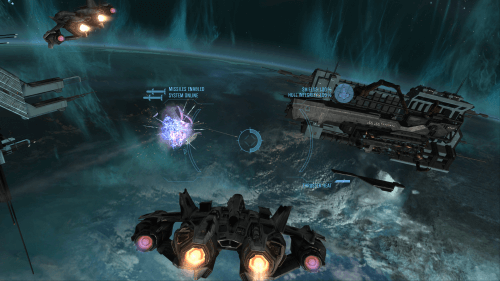
“Now do a barrel roll!”
Those new fighters are specific to what is probably the biggest new feature of the game, the space sections of the mission “Long Night of Solace”. In these sections you pilot the new Sabre fighter in what feels a little like the Star Wars: Rogue Squadron games or the more freeform Star Fox levels. While I thought those sections were an interesting addition to the already good amount of gameplay variety available in Halo campaigns, some people absolutely hated it. As a personal anecdote, every time Reach comes up in conversation with my brother, he always complains about this particular mission, claiming to have been stuck on this part of the campaign since 2010. Ha! The new Falcon also gets some dedicated time in “New Alexandria”. Beyond these sections, Reach features the typical selection of levels from on-foot corridor-running CQB sections, more open on-foot areas, sections reliant on running Warthogs and Scorpion tanks, and of course, most missions mix up all of these. There’s a lot of variety in the environmental aesthetics of these sections too. It all feels appropriately very Halo and about the only thing Halo: Reach is missing is another “Warthog Run” section.
There’s a lot more I could go into about Reach: the weird AI-centered sidestory found on the datapad pickups in the campaign, the numerous changes to multiplayer including an overhauled progression system and the new epic Invasion mode, bringing back Firefight for more co-op shenanigans, greatly expanded Forge and Theater modes, etc. It’s overall one a hell of a package, and a wonderful way for Bungie to wave goodbye to the series. Most importantly, the love Bungie put into it is obvious, and while it might not have the staying power as the mainline Master Chief installments of the series, it’s story was at least uniquely impactful.
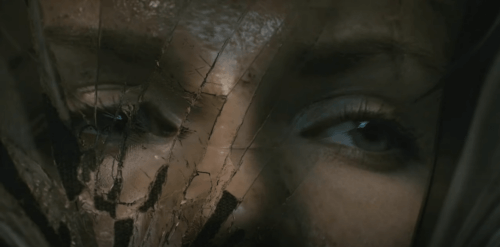
“Kat is having a bad day.”
As with my last few entries, I’ll end by touching a bit on the awesome live action promotional content developed around Halo: Reach. There’s “Birth of a Spartan” which is a short that shows Carter-A259 being transformed from a young trainee into a SPARTAN-III and “Remember Reach” which depicts numerous citizens of Reach as they go about their normal lives, oblivious to the impending Covenant invasion. Neat but not essential. “Deliver Hope” on the other hand is absolutely essential! This live-action trailer shows NOBLE team in a battle to defend the colony Fumirole as they attempt to get a fusion bomb onto a Covenant battlecruiser to destroy it. Go watch it if you haven’t seen it!
I got so many amazing screenshots this time around, it really was quite an effort to not just replace all of this rambling with a huge image galley and drop the mic!
